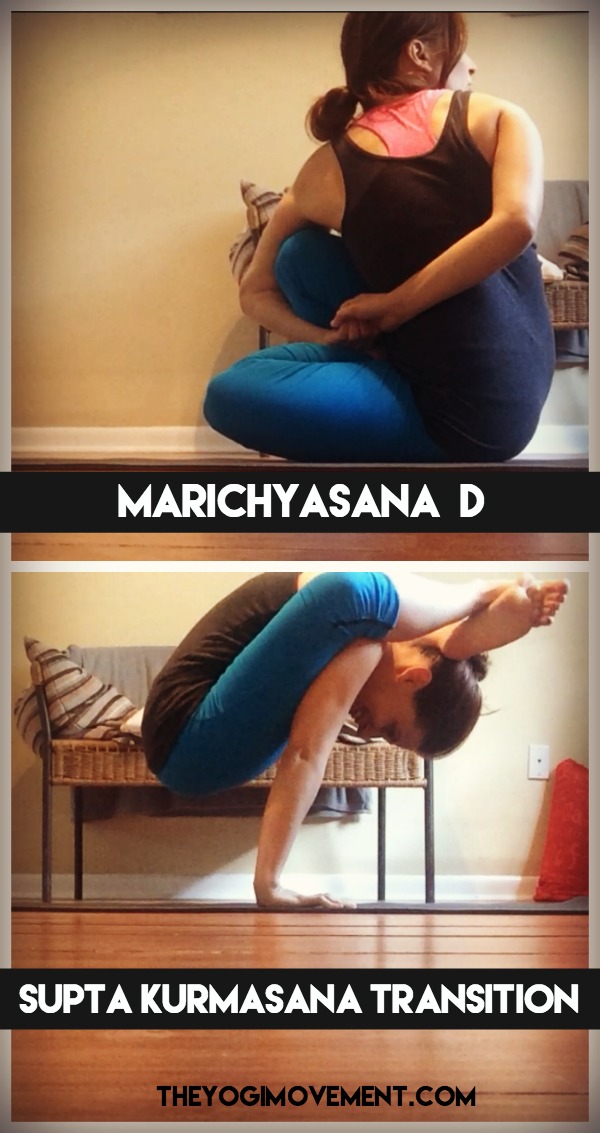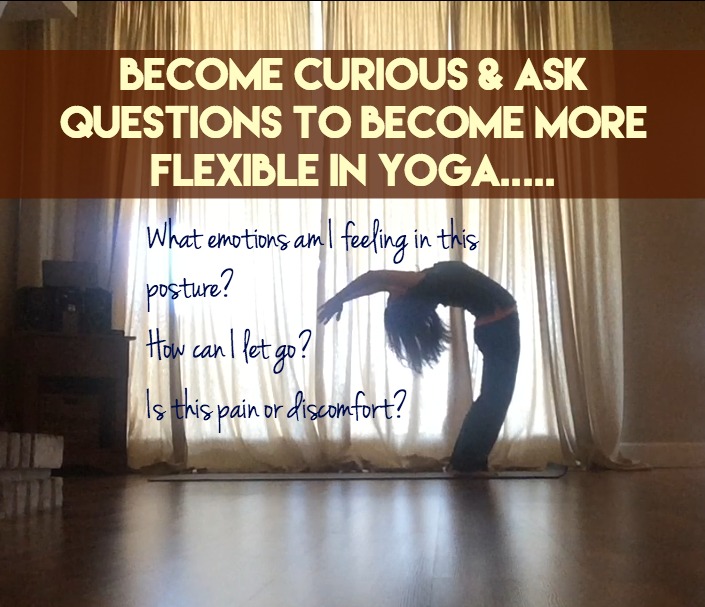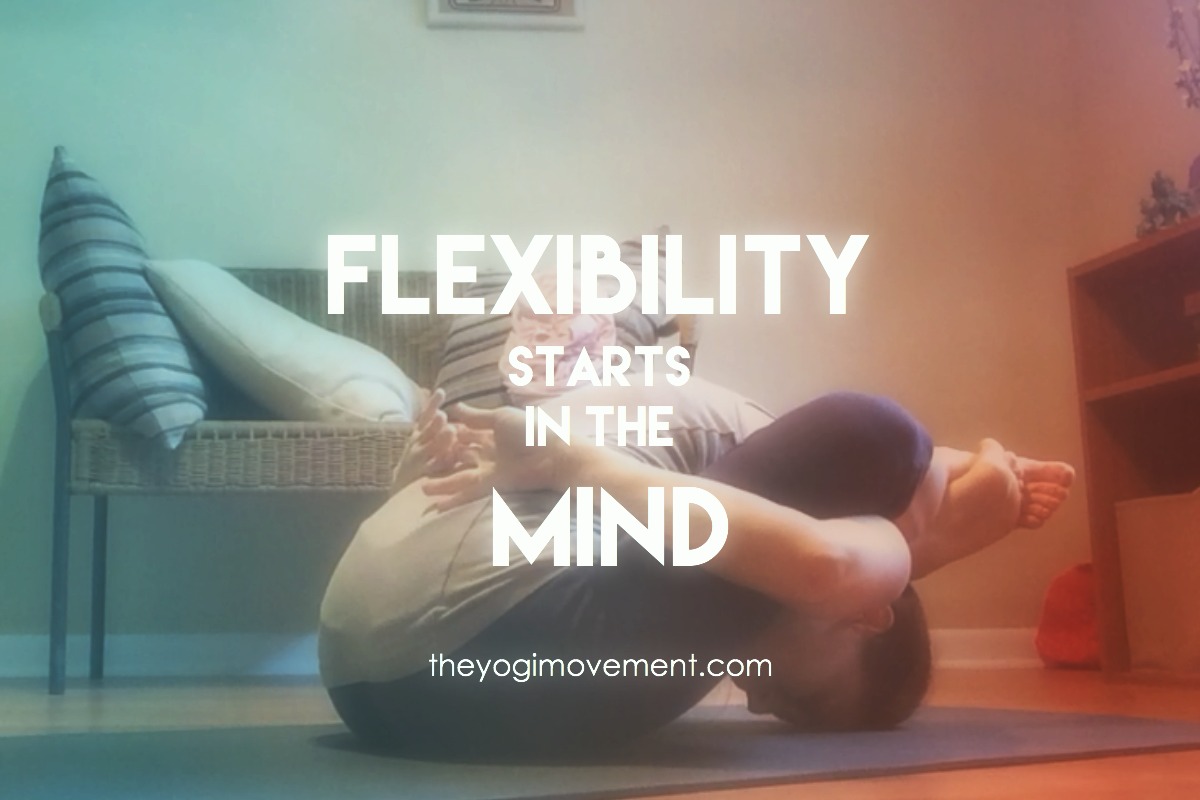Sometimes I get questions about how to become more flexible.
How do I open my hamstrings, so that I can touch my toes?
How do get my leg behind my head?
How can I deepen my backbends?
First I want to say that I’ve done all of those things. Two of the most difficult postures for me are Supta Kurmasana, and Marichyasana D. This isn’t a surprise as they are all considered gateway postures of the Ashtanga Primary Series. Many people struggle with these postures for a period of time, and sometimes a lifetime.

I still have random days where I can’t grab my fingers in Supta Kurmasana, and where my arm continues to slip off my knee in Marychyasana D. Most of the time, I dread Supta Kurmasana, but I have done it enough to know that it’s just uncomfortable.
It never hurts, and eventually feels good once I breathe into it. But, going into it – I have to really look inwards, take a deep breath, and find strength in every part of my body.
I have to constantly remind myself that I need to use the strength in my upper body and open my heart to hold myself up. I think that’s a symbolic life lesson that this posture is teaching me.
And, if for some reason I am not as strong as I was the day before, I just do what I can. I’m still trying and breathing through it.
It doesn’t always have to be so intense. It doesn’t always have to be perfect. It just needs to be the best I can with the tools I have in that moment – on that day.
The body is different everyday, so that’s a big part of the ashtanga yoga journey. It’s a life lesson about learning acceptance, compassion, and going into it without expectation – being okay with the journey – not the destination.
I’ve been practicing for about 10 years, and I have to say I’m just scratching the surface.
Once I think I know everything, it turns out I know very little. I’ve come so far, yet I’m always a beginner.
There was a time when I spent a lot of time trying a bunch of extra postures to enhance my flexibility. I really wanted to “master” these postures, but it never worked. Sometimes it worked temporarily, but it never lasted.
You know how if you go on a diet, and you try to force weight loss, it might happen for a few days, but it always rebounds? The only way to change your weight is through a lifestyle change. When you start eating healthy, you start to feel better inside and out. You start to glow, and not only do you take the weight off, but you’re happier, you make healthier choices, and you shine!
Flexibility, strength, and yoga postures are the same way. You can do all of these stretches, but the real change comes from a mindset shift.
Here’s what I mean:
Yoga is actually not stretching – it’s letting go: That being said, it’s okay if you are stretching. You might be doing yoga because you have pain, you’re a runner, or a doctor prescribed it for stretching your muscles. But, even in that case, you’re still going to need to go slow, and feel what’s going on before your body makes real change. Your body has muscle memory, and it will continue to react the same way.
So, if you stretch too intense, then your body is going to pull back. Your body will remember that, so it takes much longer to open, and you’re more prone to injury.
This is not really yoga.
You might have small moments of openness, but it won’t last because you’re not actually letting go – you’re pushing and pulling.
Just like a fad diet, the results will be temporary.
So, how do you actually open? How do you actually do yoga if you’re not stretching?
This is a great question. Over the last month I have been really paying attention to what I’ve been doing in my practice to really let go and open.
[Tweet “Want to become more flexible? Here are 4 things you need to be doing during your yoga practice to get you there.”]
1. BECOME CURIOUS & ASK QUESTIONS:
You need to close your eyes and feel what’s going on. You need to focus your drishti inwards. You want to really tune into the body parts, and become curious about how to open. If you’re feeling any pain or discomfort, ask why.
Ask questions about what’s going on. Where is this tightness coming from? Where is this pain coming from? Is this actually pain? Or, is this discomfort? What emotion is associated with this pain or discomfort?
You can even go deeper once you understand the pain and say, “Hey hamstring, why are you so tight?” Or, “What is this anger that rests in my shoulders? What can I do to release this anger?”
If it’s in a backbend, it might actually be panic or stress that you’re confusing for pain. If you really listen, then you’ll discover what’s going on. If it’s in your hamstrings, it might be anger or sadness. Ask what you need to let go of. Ask how can you shift and change to open more.

2. BE PATIENT AND ACCEPT YOURSELF:
The first few years I was just focused on doing postures and breathing, but it wasn’t until I started my home practice when I started to focus inwards and learned how to let go inside my body. It wasn’t until years later when I started to understand the difference between pain, discomfort, and emotions in my body parts.
Accept where you are, and the feelings that you’re having.
Accepting yourself in this moment is what will make you more compassionate, empathetic, and loving towards others – and that is yoga, my friend.
That’s part of the journey and process. The work is in observing your mind. You know this is a trigger, and your job is just to ask,
“What’s the next step? How do I get past this? How can I let go of this trigger?”
Just keep your curiosity and asking questions!
3. CONNECT WITH YOUR BREATH:
When you’re exploring what’s going on inside, you do that through your breath. This is where the real magic happens. When you breathe correctly, you can create calmness and openness within.
When you inhale, the body strengthens and supports.
When you exhale, the body surrenders and releases.
So, anytime you go deeper into a posture should always be on the exhale. Once you realize this, it will make a huge difference in your practice. This realization came for me when I was reading about backbending in The Anatomy of Hatha Yoga.
On the Inhale, focus on strengthening and creating your support. For going into a backbend from standing bring the awareness to your strength and support, which is in the legs, core muscles, and finding extension in the spine.
On the exhale, keep your support, but let your body open and fall back. Then, inahle – strength and support. Exhale – let go and release a bit more.
You can do this for any posture. And, you don’t need to learn any of this from a book, although it doesn’t hurt to study it! But, if you just breathe, ask your questions, look within, and practice daily – you will learn where to strengthen, how to let go, and what you need to do to open.
4. CONSISTENCY IS KEY:
Your practice needs to stay consistent! Practicing daily is what’s going to be the biggest change in your body and mind. By hopping on the mat, connecting with your breath, and exploring what’s going on in your body, you’ll learn how to let go so you can finally open. You’ll learn that it’s less about pushing and pulling yourself into a posture, and more about how to surrender and release.
Find a schedule that works for you. I have a goal of practicing 6 days a week, but sometimes my life gets crazy, and I can’t get to it. Even if I can’t do a full practice, I try to at least sit and meditate for a few minutes, or do a 5-10 Sun Salutations.
What works for you? Can you commit to 6 days a week? What about 3? Is 3 or 4 more realistic. Find a consistent schedule that’s not going to cause more stress and commit to that.
This knowledge comes with a daily practice, an open mind, and the understanding that you’re going to have experience some changes emotionally.
When you stop forcing, and start allowing – that’s when things start to open.
A flexible body is a side effect of consistent practice and a strong and flexible mind! Not the other way around.
What did you learn about your own practice? Where can you focus? Do you need more consistency, more breath awareness, more curiosity? Have you asked yourself what emotions you’re having in the postures? What did you find out?
Share in the comments!


I think I fail with the consistency part!
it’s not easy, but just continue to recommit & do the best you can! You got this!
Love the tips! I like that you explained how breathing helps with the poses. I forget to focus on the breath sometimes so I really need to remember to keep that steady and use it to help me get into a pose!
Yeah totally! It’s really helpful if you can tune into the breath, and hard to remember when you’re in the heat of a difficult posture!
I Love your blog! I’m travelling in India and have ended up in Mysore for a long term stay, just doing ashtanga and meditate in a shala following a guru. I want to learn more about yoga and also debrief some concernes, and I find your blog to be a perfect place for this! Here I learn and get reliefed, inspired and more. Thank you!